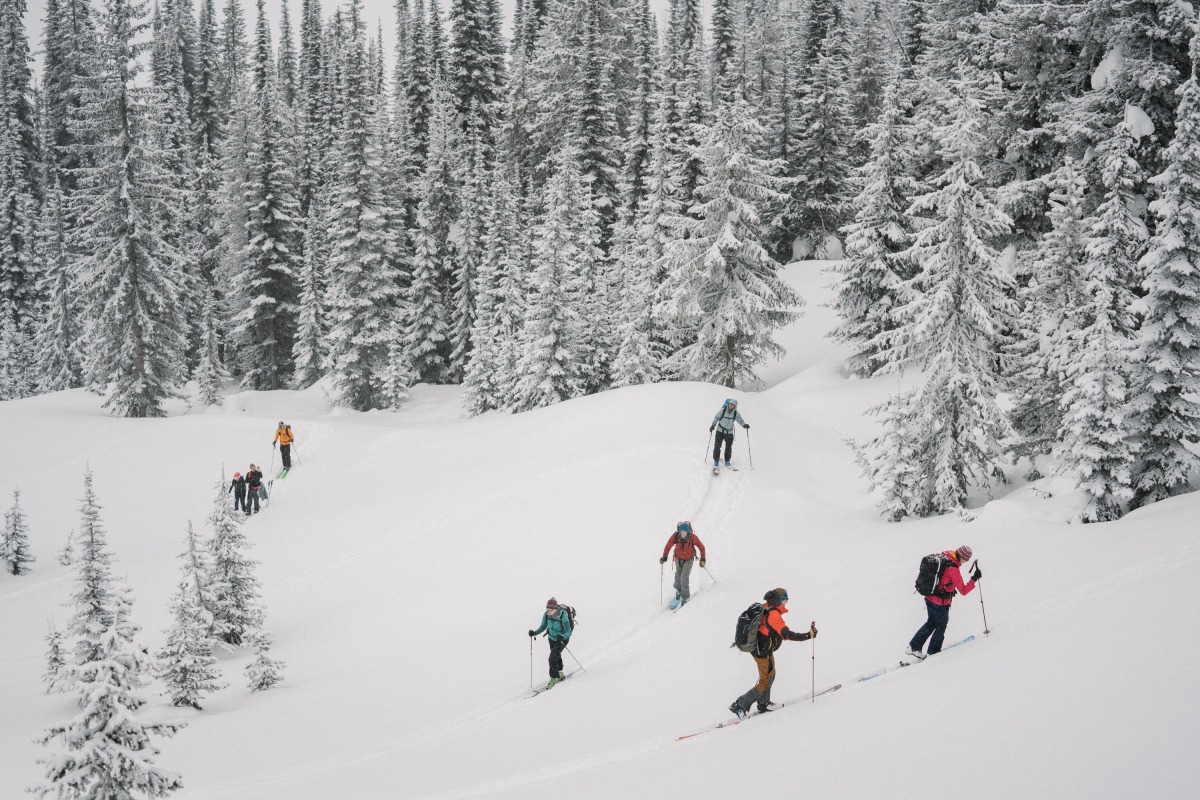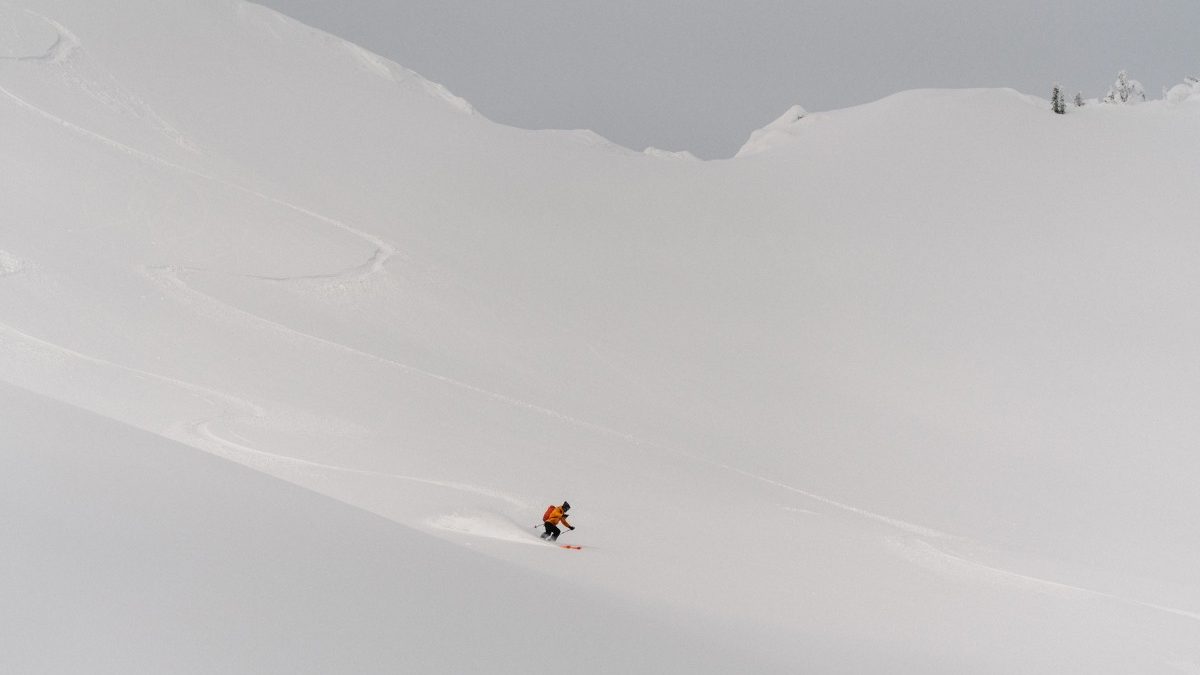
Staying on a ridgeline means nothing above you to avalanche. Headed towards the drop-in outside Nelson, BC. Photo: Matt Kennedy
Setting a civilized skin track that won’t kill you or your partners
You round the corner and before you a convoluted slope rises 1200m, with numerous obstacles and hazards between you and a col, beyond which lies bottomless pow, endless turns, and certain ecstasy. In short, this slope separates you from Paradise.
The eager, young guns might throw up the heel risers, unzip their vents, and charge straight up the fall line. The wizened veteran, though, downshifts, spends a moment connecting terrain features, and employs the Five Pillars of Wisdom to envision an optimal skintrack, one that’s safer, easier, more useful, and ultimately displays her limitless skill on the up. The young gun will arrive at the col exhausted and sweaty, having taken unnecessary risks. He will arrive in Paradise too shattered to fully enjoy it! The wily, vet, though … arrives brimming with energy and vigor, clearheaded, de-stressed, and ready for her run to remember.
Promises of ecstasy and dreams of paradise will certainly focus your energies, but let’s get serious (for a sec): we spend most of our human-powered backcountry days on the up track. In fact, the longer you’re in the game, the more you’ll grow to enjoy the up. It’s a skill we need to master, not just for our enjoyment, but to minimize hazards, too. Let’s transition and get started on our lifelong quest to master … the up.
The Five Pillars
A smarter, wiser guide could probably list 20 pillars, but I’ll stick to five to keep me on topic and prevent me from wandering too far afield. Consider these a general starting point in your track setting.
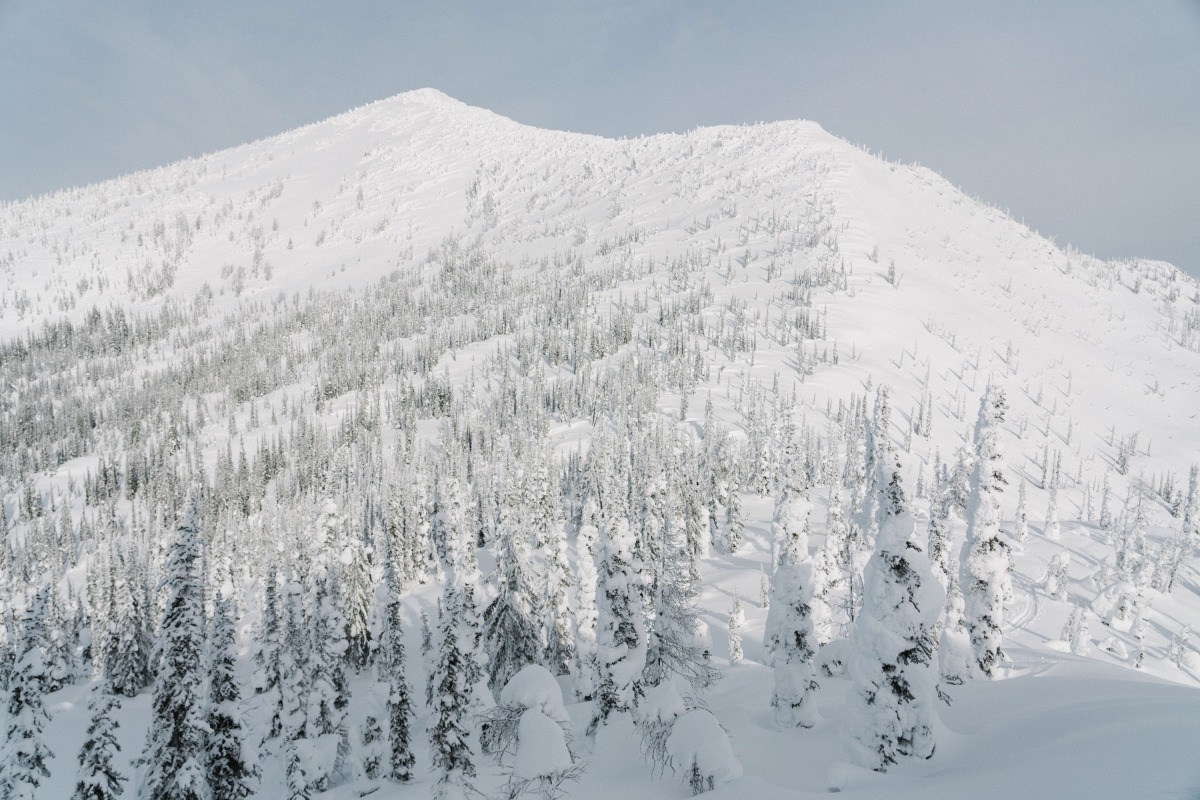
Good skiing to be had … but first you gotta get there. The deep snowpack of the Kootenays, outside Nelson, British Columbia. Photo: Matt Kennedy
Minimize exposure
First and most important, let’s stack the deck in our favor by minimizing our exposure to potential hazards. We usually think of avalanches first, and rightly so, but let’s not ignore seracs, cornices, tree bombs, other skiers and sleds, and rockfall come springtime.
When tour-planning before your field time, or eyeballing your route from the guidebook or even below, first identify your hazards. Ask yourself, “How do I get myself killed on this slope?” Answer that question and you know what to avoid. Identify connected pieces of terrain that avoids these hazards.
Imagine standing with your group and feeling stumped about low-exposure options. What does that tell you? Those of you familiar with the Avalanche Terrain Exposure Scale (or ATES) might recognize that challenging and complex terrain limits no-to-low-exposure options for an up- or down-track (descent). Ask yourself and the group; if we can’t identify a lower-exposure option, should we even consider this as a slope for an uptrack?
Remember, our exposure on the up can extend to hours, unlike many of our descents, which can be measured in minutes. Sliding past a pissed-off band of seracs in seconds feels way different than laboring uphill beneath them for 90 minutes.
Efficiency
Once you’ve picked out areas less exposed to avalanches, cornice/serac/rock-fall, or Monster-infused slednecks, try and link these zones with consistent, lower-angled terrain that will allow you to maintain a casual, efficient uptrack. Shoot for keeping your angle between 12 and 15 degrees.
What?! Indeed, no other element of track setting elicits such impassioned debate. My manorexic, skimo buddies can happily float upwards on 22-degree ramps, but for most of us, keeping your track angle much lower will let you tap the summit with energy in the tank for your descent.
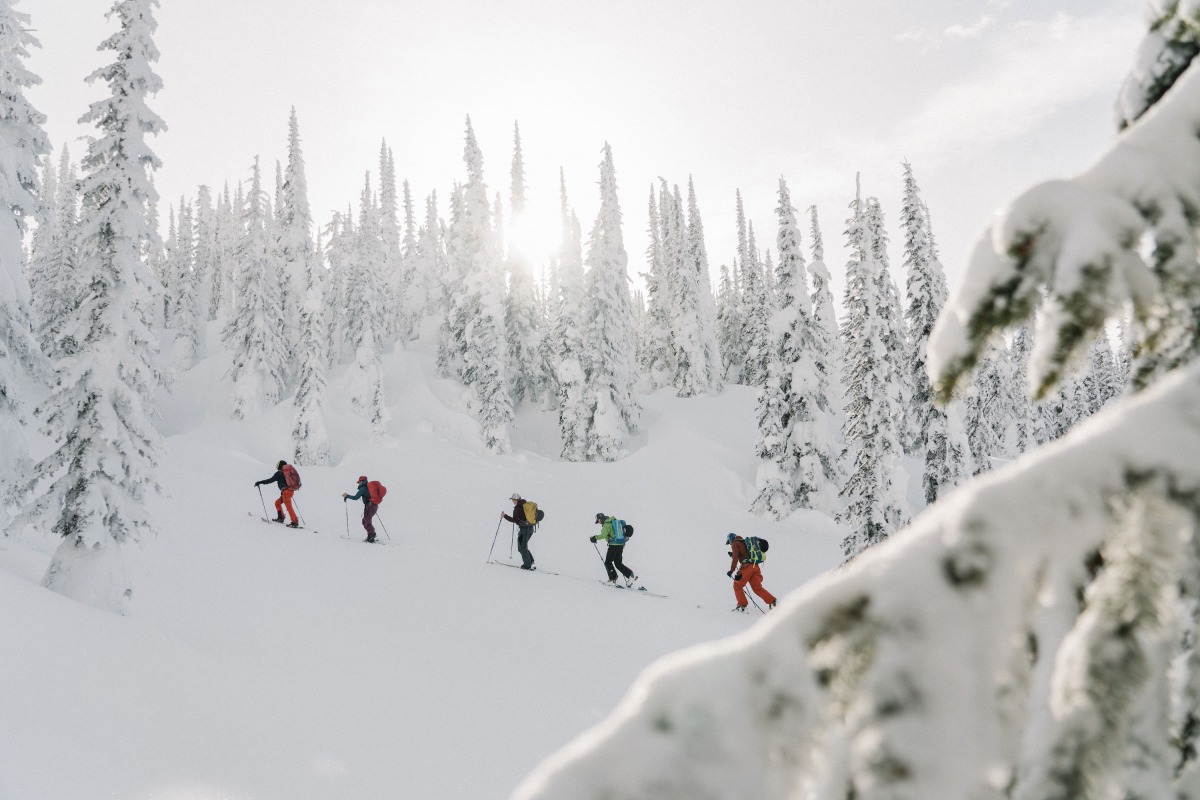
Relaxed, chatting, everybody communicating and enjoying the day. A master at work: Nate Goodman leads his team to the goods near Ymir Lodge, BC. Photo: Matt Kennedy
Taking a lower-angled line will allow you to communicate more effectively on the up, too. How many accident reports have we read where the group gets split up, the dude in the back can’t talk to the chick in the front, carnage ensues, much hindsight reveals — somebody didn’t talk to somebody else and they should have! Keep it chill, and if people aren’t talking, maybe you’re making them suffer at the back?
A gentlemanly/lady-like skintrack also keeps us off our heel risers. Fans of steeper skintracks often spend minutes on a climb fiddling with their risers. They stop at the bottom of a steeper leg, fight with their risers, then repeat the exercise at the top. Do this six times per climb and the folks behind will have smoke coming out their ears. Hit a consistent angle and let everyone get into a rhythm.
And what wrecks your rhythm worse than kick turns? Nothing. Master the kick turn and then do your best to never need them. Following a frozen track in the Alps? Sure, no sweat, bang ‘em out with aplomb. Setting your own track on a bluebird morning? Rounded turns on low-angle terrain is way faster than kick-turns.
Do long, consistent sections on your uptrack and put in a rounded turn when you need to avoid steeper terrain, a hazard, or to connect to another low-exposure, low-angle section of the slope.
Gather Info
Any expert uptrack should also maximize opportunities for gathering snowpack observations, previewing terrain, and generally gathering info. If detouring a few hundred meters will allow you to dig a pit on terrain similar to what you’re hoping to ski, then it’s probably worth the time and effort to swing over there and have a look. One enterprising teammate can even stop to dig a pit or perform a snowpack test. And if you’ve selected no-exposure terrain (to avalanches), then that teammate will feel fine being solo on the slope for a few minutes.
Often we leave the trailhead with some parameters written down in our notebook. For example, if we jot down “Minimal wind effect in start zone at col,” we’re worried there might be wind slab at the col, leading into the bowl we’d like to ski. If we’re approaching the col and we can get a look at it on our uptrack, we can make a more informed decision once we arrive.
Your expert tracksetting can keep you safer, fresher, and now wiser for the upcoming decision. Good job!
Communicate and enjoy
We’re having fun, right? Hammering uphill in your top risers doesn’t often leave much bandwidth for fun. Especially on a week-long hut trip, we might get away with a day or two of that, but it takes an exceptionally fit team to pull that off for a week.
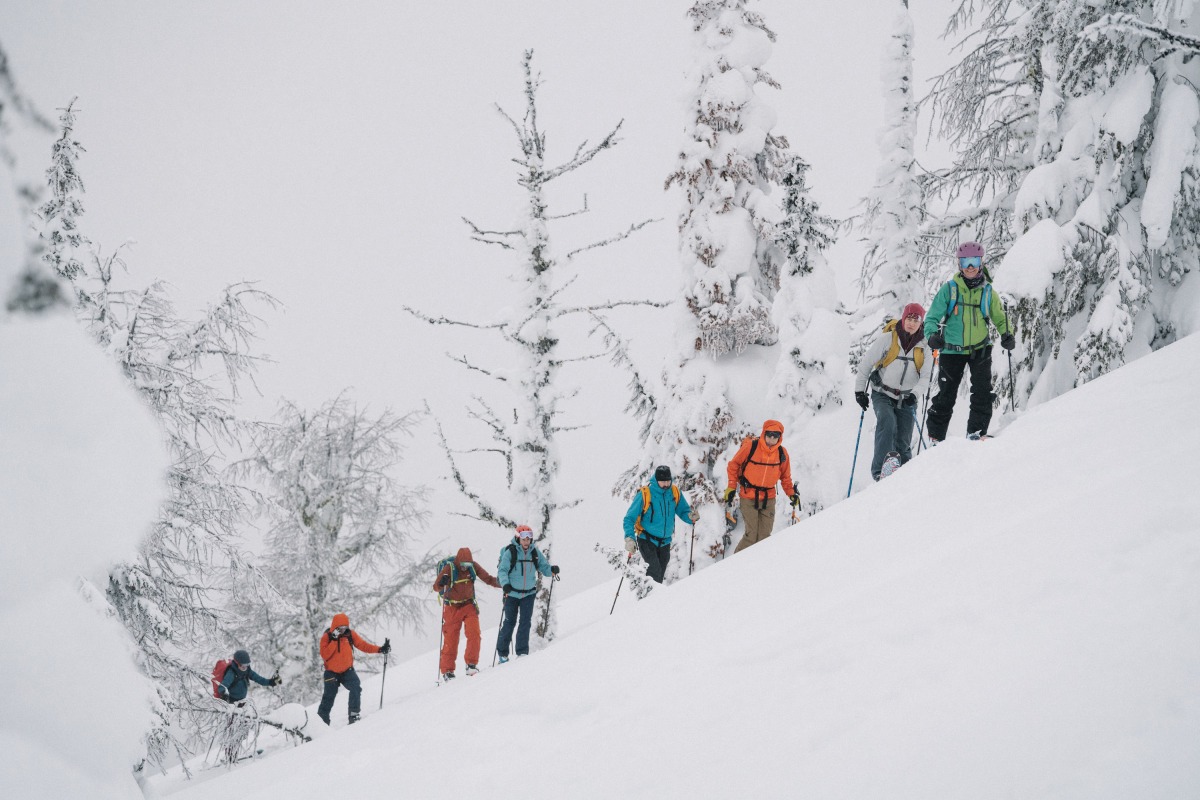
By traversing a steeper pitch, former ski racer and UVM alum Cathy Pacocha keeps the angle low … and the stoke high. Photo: Matt Kennedy
Rest stops, decision points, and observations can happen in more or less beautiful spots. When you can, make it a nice, flat area, where everyone can hang and enjoy. A group of six, stretched out on a steeper slope in dense timber — that’s not that cool!
Keeping the vibe right also facilitates communication. Picking a relaxed, enjoyable spot to hang, or a civilized pace, all keeps the conversation going. This might be critical during a hilarious story, but it’s also critical in maintaining the right culture for teamwork and shared observations.
The master reveals it in her every action
Before ripping skins, locking down the heels (or not), stepping into the splitboard, or making that final decision — turn and revel in the elegant, lithe, carefully crafted skintrack that delivered you to the col. It should look like someone smoked a fatty and floated up the hill on a magic carpet woven of equal parts wisdom and blissed-out enlightenment.
Make your skintrack your signature, a representation of your mastery. You should look downhill and see others actively choosing your track, over the steep one punctuated by kick turns and vomit blotches.
In short, take pride in the skintrack you set. People should feel relaxed, safer, and psyched following your uptrack.
And now, quick, before those jokers behind you catch up, check in with the team, lock ‘em down, and harvest the goods. Welcome to paradise.
Rob Coppolillo lives, guides, and writes from his home base in Chamonix, France. Once in a while he crafts an acceptable uptrack. You can check out more backcountry info in his book, The Ski Guide Manual.
Fueled by snow and captivated by any landscape it covers, Matt Kennedy is a skier, photographer, and video jack-of-all-trades who thrives in the cool-crisp air of winter. See more of his photography on his website and Instagram @iammattkennedy.
Rob Coppolillo is a mountain guide and writer, based on Vashon Island, in Puget Sound. He’s the author of The Ski Guide Manual.

